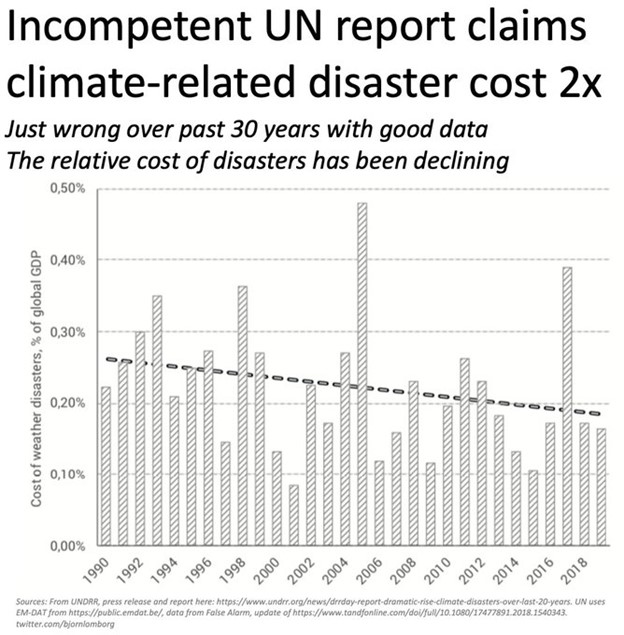In a report, titled “How Bad Are Weather Disasters for Banks?,” staff of the Federal Reserve Bank of New York (NYFed) conclude weather disasters are having minimal effects on banks’ performances over the past century. This conclusion is consistent with findings reported in Climate Realism showing that the costs related to extreme weather events have fallen significantly over the century.
In answer the question posed by the title of the report, “How Bad Are Weather Disasters for Banks?” authors Kristian S. Blickle, Sarah N. Hamerling, and Donald P. Morgan write:
Not very. We find that FEMA disasters over the last quarter century had insignificant or small effects on U.S. banks’ performance. This stability seems endogenous rather than a mere reflection of federal aid. Disasters increase loan demand, which offsets losses and actually boosts profits at larger banks. Local banks tend to avoid mortgage lending where floods are more common than official flood maps would predict, suggesting that local knowledge may also mitigate disaster impacts.
In short, the impact of hurricanes, wildfires, floods, and other weather related disasters that FEMA is responsible for responding to, has not materially impacted banks’ performance or their fiscal soundness.
This finding is consistent with separate data presented by Roger Pielke, Jr. Ph.D. (see figure 1, below) and Bjorn Lomborg, Ph.D, (see figure 2, below), both of whom find that when adjusting for inflation and the size of the economy as measured by Gross Domestic Product, as the United Nations does, the costs of weather related disasters have fallen over the past 30 years of modest warming.


As discussed in Climate Realism reports here and here, for example, rising disaster costs, in nominal dollars—the present value of dollars, not inflation adjusted—is a function of demographics and wealth, not worsening climate conditions.
As documented by Climate at a Glance, floods, hurricanes, and wildfires are either relatively stable or have declined during the past 100 years of global warming. However, increasing numbers of people are moving into harm’s way each year. More people are choosing to follow their dreams and live near coasts, which are prone to hurricanes, rising seas, and land subsidence; rivers, which are prone to flooding; and forests and mountains, which are prone to wildfires. And these growing populations are developing more expensive properties accompanied by extensive infrastructure. When people move to locations already prone to extreme weather events and construct expensive property there, when natural disasters strike, even if they are not more intense than before, they result in higher nominal costs.
Climate change is not resulting more frequent or more intense extreme weather evets, thus it can’t be causing a rise in the costs of such events. Also, the evidence presented by the NY Fed indicates banks are not being placed are risk of insolvency from, or suffering losses due to, weather disasters. Rather, large banks are modestly benefitting from the reconstruction after such disasters, while local banks are using their knowledge of the disaster prone areas near them to avoid making risky loans on properties located in such areas.
















